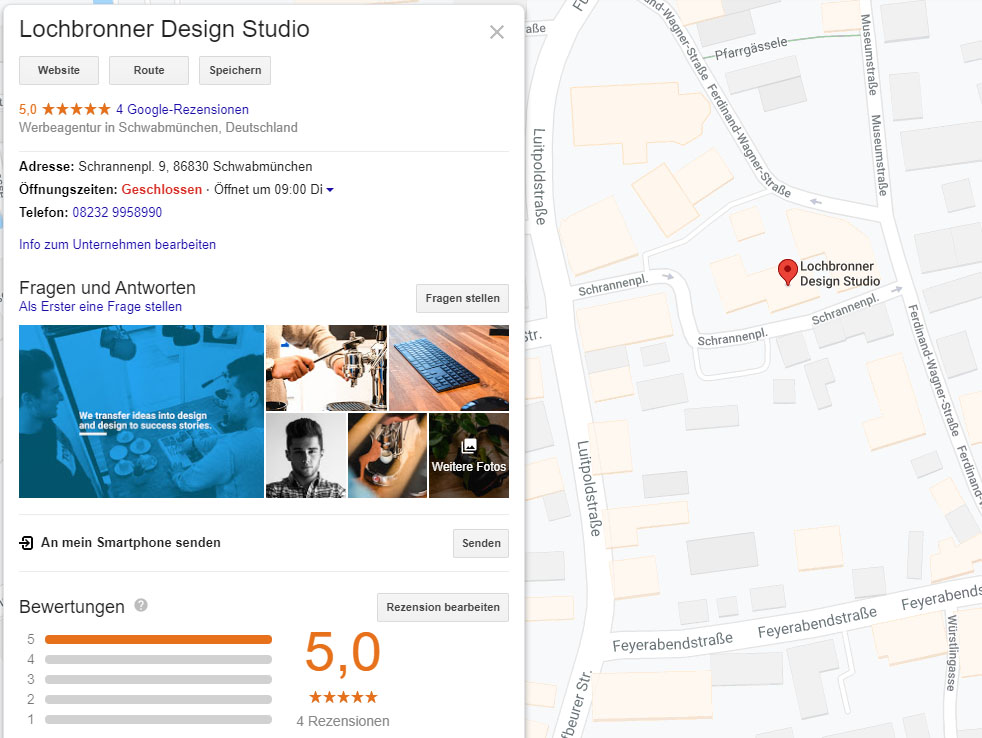
Visibility on the Internet is more important than ever for companies today. Only discoverable websites lead to site visitors and thus to new customers. Conversely, this means that even the "best" website is of no use without users. In this article, we will take a closer look at regional searches, for example queries such as "lawyer Schwabmünchen", "dentist Landsberg" or "advertising agency Augsburg". Let's start with the basics of Local search engine optimization.
All search queries that have a regional reference are summarized under the term "local search". These are, for example, search queries for a service, a restaurant or a store in the vicinity. The user can either also name a specific location, in which case the regional reference is very clear for Google. But even without naming a location, Google assumes the regional intention for certain searches. For example, a user searching for "hospital" will generally be more interested in the surrounding hospitals. How does this work without a location? Search engines simply use all the data they have on the respective user. Of course, this works most easily if you have granted access to your own location. But other user-related data that has already been collected from the user can also be used to personalize the search results.
In local searches, users are most often interested in the following information about a regional business:
You can already see that the possible information is much more comprehensive than was the case in the days of telephone directories and printed business directories. The information is also more up-to-date and easier to maintain. For example, seasonal changes to opening hours can be recorded quickly. Of course, this also increases the complexity of maintenance - because only if the same, consistent data is stored everywhere online does this have real added value for the customer. It would be very confusing for the customer to find different information on opening hours, telephone numbers etc. on different pages. Google doesn't particularly like this either, which can lead to a poorer ranking in the local listings.
Everyone knows it - you're on the road and quickly need the right opening hours or want to grab a quick bite to eat. The next logical step is of course to search Google, for example for "Restaurant Burger essen". Since you're on the go, you won't start sifting through and analyzing the search results now. One takes one of the first candidates suggested in the Google Local Pack. As a rule, candidates from the vicinity are shown here. Check the ratings briefly, and nothing stands in the way of enjoying the burger. Conversely, this means that if a company does not appear in the top positions for local search queries, it not only misses out on a lot of website traffic, but also the chance to attract many potential new customers. Being displayed in the local search results at the right moment should be the goal of every local business. And: If you are lucky enough to be displayed at the right moment, your profile should make a well-kept impression and ideally have enough positive references.
Google is not only ahead in organic search queries, but also in local search queries. This makes the search engine particularly important for companies when it comes to Local SEO (local search engine optimization).
First, in general, about the structure of the search results lists at Google. These usually consist of three parts:
The following graph illustrates this:

Google search for "Makler Hamburg" - the graphic shows the three different areas
The graphic shows that in the first step only 3 top results are listed in the Local Pack. Only when you click on "More places" are the other entries displayed. So if you land on one of the first 3 places, you already have a big competitive advantage. Especially in industries with many local providers, this is enormously important. For example, if you search for "Café Augsburg", you get a Local Pack list with currently over 200 entries. How likely is it that the user will visit a café on the back pages? Vanishingly small.
The user receives the following information about the Local Pack:
Beyond that, there is then the detailed view:

Google Local Pack detail view with Google My Business data
In the detailed view, the user additionally sees:
Although Google is the number one port of call for local searches, this does not mean that all other services should be neglected.
Business directories, rating platforms and social media can also be entry pages for a local search. Especially for companies that do not yet have a rating on Google, other sites can provide decisive criteria, such as positive reviews on Facebook.
You are sitting in the car and want to quickly plan a route. If the navigation system does not use a Google map, even the optimization of the Google My Business entry is of no use. This means that you should also be listed correctly in other directories. Examples are Apple Maps & Bing Maps. Various car manufacturers also use their own navigation systems with customized maps. So for businesses, with increasing services, it is a complex challenge to be found correctly everywhere.
Local optimization for search engines is profitable for all companies that have a local location where sales are generated or at least customer contact takes place. These include workshops, hotels, tax consultants, doctors, supermarkets, gas stations, restaurants, fitness studios, hairdressers and many more. The Internet presence should then be optimized with regard to the topics and the keywords for its regional reference. Especially when services and products are primarily offered offline instead of online, local search engine optimization provides a significant advantage.
With the optimization of the Internet presence, an important foundation stone is laid. However, one should always keep in mind that the organic search results only land in the 3rd area, i.e. below the paid Google ads and below the Local Pack. Therefore, it is essential to also deal with the ranking factors for the Local Pack. As things stand, the website itself has little influence on this area, which is why further measures need to be taken.
Our starting point is the Google My Business entry, which can be seen in the Local Pack. Google My Business is Google's own business directory and probably the most important business directory in the world. It is crucial for the ads in the Google Local Listings as well as on Google Maps. The three most important factors for the Google My Business entry are the so-called NAP data: Name, Address, Phone Number. These three pieces of data should be the same everywhere on the Internet, i.e. also on Facebook, Yelp, Foursquare, Bing, Apple Maps, etc. Synchronizing these values is probably one of the most important things you can do for Local Listing.
In addition, there are some other details, which should be the same everywhere. These are, for example, the opening hours and the website.
There are also important ranking factors, which cannot be easily changed by companies, but are still important for Google:
If you now summarize all the information, you get a pretty good picture of what Google considers important for Local SEO. If you want to come up with a simple strategy, it could consist of the following building blocks:
In the following, we will delve a little deeper into the topic. This information is more interesting for technically experienced readers.
Schema is a structured data markup developed by Google, Microsoft, Yahoo and Yandex. The official website is Schema.org. If you want to use this markup to be even better positioned on Google, then you should always follow the official Google guidelines hold. Under no circumstances should you try to be smarter than the search engine. If the approach is classified as spam, the shot can quickly backfire.
The own page can be easily created with Google's Test tool for structured data be checked. The data for the physical location (local business) is interesting. In addition to the company name and address, opening hours, geodata and the logo can also be marked.
There are many helpful tools online to get a clean script generated for your own website. One of them is for example the Schema Markup Generator (JSON-LD) from TechnicalSEO.com.
The topic of Local SEO is extremely relevant for us at the moment. Therefore, we will supplement this article with further helpful information at regular intervals.
Looking for help with local SEO optimization? We are happy to help: Contact us
Sebastian Lochbronner
86830 Schwabmünchen
Germany